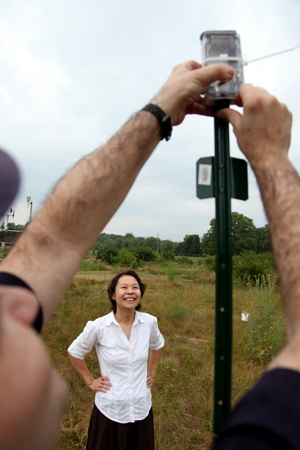Prof. Mingyan Liu receives Best Paper Award at the 11th ACM/IEEE Conference on Information Processing in Sensor Networks
The goal is to be able to monitor the soil moisture with as few measurements as possible and with a high degree of accuracy.

 Enlarge
Enlarge
The paper, “In-Situ Soil Moisture Sensing: Measurement Scheduling and Estimation using Compressive Sensing,” by Prof. Mingyan Liu and Xiaopei Wu (a visiting student at the time), was named Best Paper at the 11th ACM/IEEE Conference on Information Processing in Sensor Networks.
In this paper, the researchers considered the problem of monitoring soil moisture over time using a wireless network of underground sensors. The ultimate goal is to be able to monitor the soil moisture over time with as few measurements as possible and with a high degree of accuracy, using a technique called compressive sensing.
Soil moisture data is required for many scientific applications, including land surface models, water and energy balance models, weather prediction models, general circulation models, and ecosystem process simulation models. It also aids in precision farming and agricultural drought monitoring.
The authors successfully employed compressive sensing to take soil moisture readings that minimized the total amount of time the node remained active in actuating the moisture probes and in data transmission, and that also ultimately achieved an adequate level of accuracy from the measurement data collected. To be specific, they were able to achieve very low estimation error at no more than 10% of the standard sampling rate.
They applied their results to the SoilSCAPE (Soil moisture Sensing Controller And oPtimal Estimator) project, where soil moisture sensor probes have been placed at varying depths in the ground every few square feet and measurements are wirelessly transmitted to a base station for processing. [see also: Understanding climate change from the ground up (with video)]
Prof. Liu and Xiaopei Wu estimated that the lifetime of a wireless node in SoilScape using their newly-developed system would increase from approx. 6 months to 5 years by taking samples at 100-min. intervals rather than 10-min. intervals. Key to the success of the system is a 10-fold reduction in the amount of transmitted data, and the employment of long periods of sleep mode for the sensor nodes.
The research for this paper was conducted as part of the SoilSCAPE project, which is supported by a large team including Profs. M. Moghaddam, D. Teneketzis, D. Entekhabi, Y. Goykhman, Q. Wang, Y. Liu, A. Silva, M. Burgin, A. Kakhbod, and A. Castillo. It is enabled by two grants administered through the Earth Science Technology Office, Advanced Information Systems Technologies program (AIST): “Soil Moisture Smart Sensor Web Using Data Assimilation and Optimal Control” (NASA grant NNX06AD47G); and “Ground Network Design And Dynamic Operation For Near Real-Time Validation of Space-Borne Soil Moisture Measurements” (NASA grant NNX09AE91G).